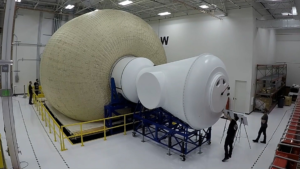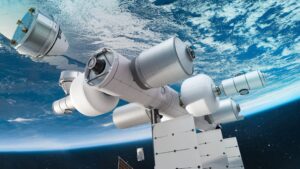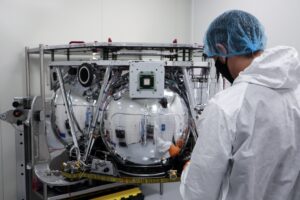
Why Is Rocket Lab Dropping Boosters In The Ocean?
Over the past few years, Rocket Lab’s Electron Booster recovery method has changed quite a bit. What once consisted of catching the first stage out of mid-air with a helicopter has shifted toward a more conservative yet still ambitious approach.
Nowadays, it’s somewhat common to see images of the booster floating in the ocean as the company works to retrieve it. This is what happened just days ago as part of the “Four Of A Kind” mission, and based on what Rocket Lab has said, it seems to be working quite well for the company. Here I will go more in-depth into this recovery method, how it’s changed over time, why it’s so important, and more.
Ocean Recovery

Very recently on January 31st, Rocket Lab launched another Electron mission that successfully deployed four Space Situational Awareness (SSA) satellites for its customers. As part of that mission, they also planned a booster recovery. Here, after the upper stage separated from the first, it began falling back toward the Earth. Eventually, it deployed a parachute and splashed down in the ocean around 18 minutes into the mission. Soon after Rocket Lab tweeted saying, “Gon’ (rocket) fishing.” This included a number of images of the recovery process. Specifically, Rocket Lab’s recovery vessel locates and moves to the booster where it then extracts the stage from the water for transport back to Rocket Lab’s production complex for assessment.
Despite the booster which is full of engines, internal tech, etc, being exposed to salt water, Rocket Lab has been trying to alter the booster to ensure this process creates minimal damage and inconvenience. “There are some internal vehicle changes to improve its ability to keep water out of the areas where we don’t want it,” said Rocket Lab CEO Peter Beck, in an interview. “We’ve taken this next opportunity to improve the watertightness of the vehicle.” He also commented that the new method of getting Electron out of the water “makes it much simpler to recover and much less likely to damage the stage during recovery.”
Beck said the company is taking a “methodical” approach to reusability, making incremental steps that get it closer to full reuse. On one of the previous attempts he said, “I’m sure we’ll learn something from this mission and we’ll probably make some tweaks again to the next one. We’re methodically walking step-by-step and taking the opportunity to get it right.” He added that while reusability was an “important economic lever” for the company, it was not an urgent requirement. The company has previously emphasized that reusability would allow it to increase launch activity without having to scale up its factory. This highlights that while Rocket Lab is absolutely trying to reuse the first stage, it’s not a top priority that the company depends on. This will likely contribute to the timeline and how long before we see a reused booster lift-off.
Looking at other reuse progress, by now the company has already confirmed that the 9 Rutherford engines can be refurbished after a splashdown and recovery. A while ago, Rocket Lab successfully test-fired a reused Rutherford first-stage engine for the first time.
The company conducted the full-duration, full-thrust test fire of the refurbished Rutherford engine at their engine test facility. The engine was previously successfully launched to space and returned to Earth during Rocket Lab’s recovery mission, ‘There And Back Again’, launched on May 2, 2022. Despite being exposed to water, the refurbished Rutherford engine passed all of the same rigorous acceptance tests Rocket Lab performs for every engine, including 200 seconds of engine fire and multiple restarts. Data from the test fire shows the engine produced full thrust of 21kNs within 1000 milliseconds of ignition and performed to the same standard as a newly built Rutherford engine. It’s also important to point out that this was without a host of changes to the booster to make it more waterproof.
In the coming months, we can expect a few more booster splashdown attempts each with a slightly upgraded Electron booster. Until they get this process perfect, they will continue to try. All this being said, besides the progress made on the recent flight, the company has already tested and made clear that the engines can be reused.
Changing Plans

Interestingly, Rocket Lab actually tried a different recovery method before the one in use now. Originally, the plan was to catch the boosters out of mid-air with a helicopter. Unfortunately for the company, this proved to be a bit too inconsistent.
Starting in May 2022, launched from Pad A at Rocket Lab Launch Complex 1 on New Zealand’s Mahia Peninsula, the “There And Back Again” marked the company’s 26th Electron launch. This mission was a recovery mission where, for the first time, Rocket Lab attempted to catch Electron’s first stage as it returned from space under parachutes using a helicopter. During the mission, after launching to space, the parachute deployed as intended. At 6,500 ft, Rocket Lab’s Sikorsky S-92 helicopter rendezvoused with the returning stage and used a hook on a long line to capture the parachute line. However, soon after the catch, Rocket Lab reported that the helicopter pilot detected different load characteristics than previously experienced in testing and offloaded the stage for a successful splashdown. The stage was then loaded onto Rocket Lab’s recovery vessel for transport back to the Company’s production complex for analysis and assessment for re-flight as planned. This was a partial success for the company as they managed to hook onto the booster in the air but not properly.
Next, later that year in November, they tried another catch during the Catch Me If You Can mission. Similar to the previous attempt, the goal was to catch Electron’s booster out of mid air using a helicopter. In this case, the company was once again unsuccessful. Specifically, Rocket Lab reported that they had planned to attempt a mid-air capture of Electron’s first stage with a helicopter if conditions allowed. However, there were too many clouds which in combination with a host of reasons stopped the pilots from attempting a catch. As a result, the booster ended up splashing down in the ocean. In regard to this failed attempt, at the time Peter Beck commented, “This turned out to be quite a happy turn of events. Electron survived an ocean recovery in remarkably good condition, and in a lot of cases its components actually pass requalification for flight” he said. This failed attempt combined with the promising ocean splashdown result ended up changing the company’s mind about recovery methods.
One of the biggest conveniences was the similarity between the two methods. In preparation for catch attempts, Rocket Lab worked to ensure the booster could survive reentry and slow itself down. Not long after stage separation, the booster is subjected to intense pressure and heat, experiencing flow temperatures in excess of 2400 °C and reaching speeds of 2350 m/s during its descent. They call this potentially destructive process ‘The Wall.’
One of the ways they set out to survive ‘The Wall’ was by using a reaction control system (RCS) to position the stage as it falls. Using the RCS they are able to reorient the stage to an ideal angle as it descends. This tech in addition to Rutherford heat shielding, the drogue parachute and main parachute were already in place. Rocket Lab mainly just needed to waterproof the vehicle.
When referencing the recovery process, the company said in a statement, “As a result, Rocket Lab is moving forward with marine operations as the primary method of recovering Electron for re-flight. This is expected to take the number of Electron missions suitable for recovery from around 50% to between 60-70% of missions due to fewer weather constraints faced by marine recovery vs mid-air capture, while also reducing costs associated with helicopter operations” they said.
To add to this, Rocket Lab Founder and CEO Peter Beck commented, “By evolving Electron into a reusable launch vehicle we plan to further increase our already steadily rising launch cadence, offering more launch availability to our customers at a time when space access is severely constrained globally. Reusability for small rockets is immensely challenging as they simply don’t have the fuel margins that larger rockets have to enable propulsive landing.”
He continued by saying, “In 2022 we proved that it was possible to rendezvous with a returning stage mid-air and get it on the helicopter hook, but if we can save ourselves the extra step by just plucking it out of the water we will. What the water landing does enable us to do is recover more vehicles because we don’t have the constraints of the operations of the helicopter,” he said. “So, financially it’s kind of the same, but we get to actually reuse more vehicles.” By now, Rocket Lab is likely getting close to consistent booster refurbishment and reuse. Something that would only add to the cadence and success of the Electron vehicle. Even though they are also developing Neutron which will be a more advanced reusable vehicle, Electorn could still benefit both the company and its customers. Something to look forward to in the coming years.
Conclusion
Rocket Lab just landed another Electron booster in the Ocean. For a while now the company has been testing this process and working to waterproof the vehicle. We will have to wait and see how it progresses and the impact it has on the space industry.



